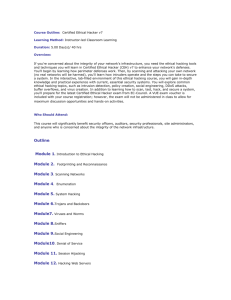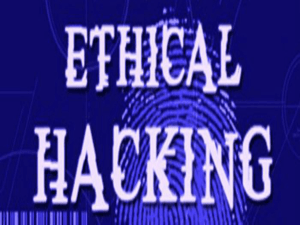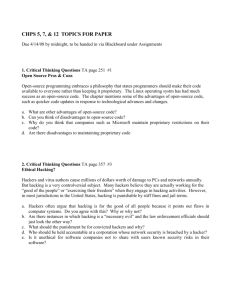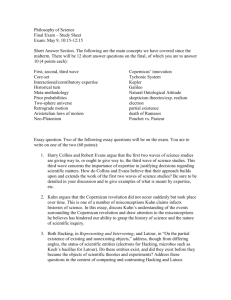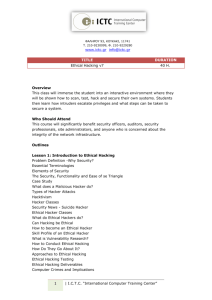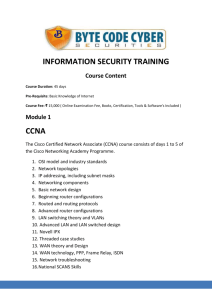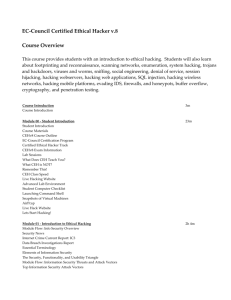Ethical Hacking and Countermeasures 5.0 Hacking and
advertisement
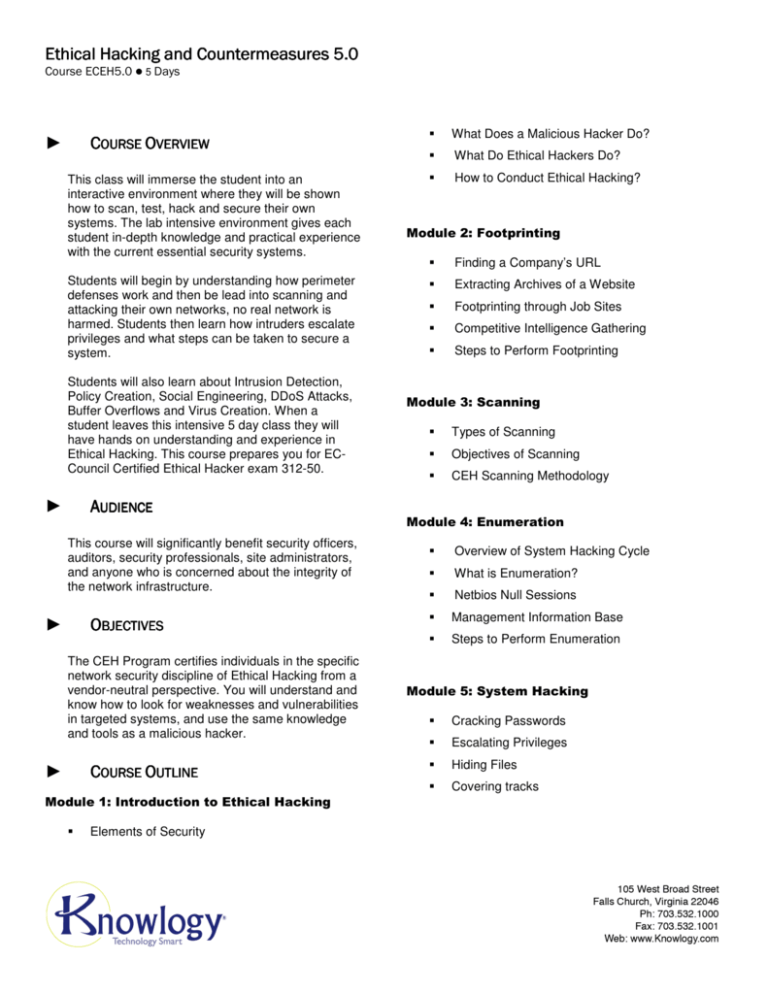
Ethical Hacking and Countermeasures 5.0 Course ECEH5.0 5 Days COURSE OVERVIEW ► This class will immerse the student into an interactive environment where they will be shown how to scan, test, hack and secure their own systems. The lab intensive environment gives each student in-depth knowledge and practical experience with the current essential security systems. Students will begin by understanding how perimeter defenses work and then be lead into scanning and attacking their own networks, no real network is harmed. Students then learn how intruders escalate privileges and what steps can be taken to secure a system. Students will also learn about Intrusion Detection, Policy Creation, Social Engineering, DDoS Attacks, Buffer Overflows and Virus Creation. When a student leaves this intensive 5 day class they will have hands on understanding and experience in Ethical Hacking. This course prepares you for ECCouncil Certified Ethical Hacker exam 312-50. What Does a Malicious Hacker Do? What Do Ethical Hackers Do? How to Conduct Ethical Hacking? Module 2: Footprinting Finding a Company’s URL Extracting Archives of a Website Footprinting through Job Sites Competitive Intelligence Gathering Steps to Perform Footprinting Module 3: Scanning Types of Scanning Objectives of Scanning CEH Scanning Methodology AUDIENCE ► Module 4: Enumeration This course will significantly benefit security officers, auditors, security professionals, site administrators, and anyone who is concerned about the integrity of the network infrastructure. OBJECTIVES ► The CEH Program certifies individuals in the specific network security discipline of Ethical Hacking from a vendor-neutral perspective. You will understand and know how to look for weaknesses and vulnerabilities in targeted systems, and use the same knowledge and tools as a malicious hacker. COURSE OUTLINE ► Module 1: Introduction to Ethical Hacking Elements of Security Overview of System Hacking Cycle What is Enumeration? Netbios Null Sessions Management Information Base Steps to Perform Enumeration Module 5: System Hacking Cracking Passwords Escalating Privileges Hiding Files Covering tracks Ethical Hacking and Countermeasures 5.0 Course ECEH5.0 5 Days Module 6: Trojans and Backdoors Module 10: Session Hijacking What is a Trojan? Spoofing vs. Hijacking Overt and Covert Channels Types of Session Hijacking Screensaver Password Hack Tool – Dummy lock Programs that Perform Session Hijacking Dangers Posed by Hijacking Evading Anti-Virus Techniques Countermeasure: IP Security Backdoor Countermeasures Module 11: Hacking Web Servers Module 7: Sniffers Types of Sniffing ARP Spoofing Attack Sniffer Hacking Tools How to Detect Sniffing? How Web Servers Work Unicode Vulnerability Scanners Countermeasures Increasing Web Server Security Module 8: Denial of Service Module 12: Web Application Vulnerabilities What are Denial of Service Attacks? Botnets Worms How to Conduct a DDoS Attack DDoS Countermeasures Web Application Hacking SQL Injection Cryptographic Interception Cookie Snooping Hacking Tools Module 9: Social Engineering Human Weakness Types of Social Engineering Preventing Insider Threat Factors that make Companies Vulnerable Phishing Attacks and Identity Theft HTML Image Mapping Techniques Module 13: Web-based Password Cracking Techniques Authentication Mechanisms How to Select a Good Password? How Hackers get hold of Passwords? What is a Password Cracker? Hacking Tools Countermeasures Ethical Hacking and Countermeasures 5.0 Course ECEH5.0 5 Days Module 14: SQL Injection Linux Vulnerabilities Introducing SQL injection Why is Linux Hacked? Exploiting Web Applications Password Cracking in Linux How does it Work? Basic Linux Operating System Defense Attack against SQL Servers Linux Security Countermeasures SQL Injection Blocking Tool: SQLBlock Module 15: Hacking Wireless Networks Module 19: Honeypots Evading IDS, Firewalls, Wired Network vs. Wireless Network Introduction to Intrusion Detection Systems Effects of Wireless Attacks on Business Terminologies WEP, WPA, and WPA2 Steps for Hacking Wireless Networks Denial-of-Service Attacks Module 16: Virus and Worms Module 20: Buffer Overflows Why are Programs/Applications Vulnerable? Reasons for Buffer Overflow Attacks Types of Buffer Overflows How to Detect Buffer Overflows in a Program Defense Against Buffer Overflows Virus History Characteristics of a Virus Working of Virus How is a Worm different from a Virus? How does a Virus Infect? Public-key Cryptography Latest Viruses Working of Encryption One-way Bash Functions Module 17: Physical Security Module 21: Cryptography Factors Affecting Physical Security Government Access to Keys (GAK) Laptop Theft Code Breaking: Methodologies Challenges in Ensuring Physical Security Cryptography Attacks Spyware Technologies Physical Security: Lock Down USB Ports Module 18: Linux Hacking Linux – Basics and Module 22: Penetration Testing Introduction to Penetration Testing Do-it-Yourself Testing Ethical Hacking and Countermeasures 5.0 Course ECEH5.0 5 Days Lab 1.1 Visit the Securiteam Website and Analyze Vulnerabilities Lab 3.3 Scan the Network Using Hping2 for Windows Lab 3.4 Scan the Network Using NetScan Tools Pro Lab 1.2 Visit the U.S. Cybercrime Website Lab 3.5 Scan the Network Using SuperScan 4 Lab 1.3 Visit Various Hacker Websites Lab 3.6 Scan the Network Using Floppyscan Lab 1.4 Read Ethical Hacking Agreement Lab 3.7 Banner Grabbing Using Telnet Lab 2.1 Use SamSpade Lab 3.8 Banner Grabbing Using Netcraft Lab 2.2 Use Web Data Extractor to Footprint a Website Lab 3.9 HTTP Tunneling Lab 2.3 Use GEO spider to Footprint a Website Lab 3.10 Block and restore Cookies G-Zapper Lab 2.4 Use NEOTRACE to Footprint a Website Lab 3.11 Global Network Inventory Lab 2.5 Use Which ISP Owns IP to Footprint a Network Address Lab 3.12 Mega Ping Lab 2.6 Use WhereIsIP to Footprint a Network Address Lab 4.1 Connect via a Null Session Lab 2.7 Use My IP Suite to Footprint a Network Address Lab 4.2 Use GetAcct to Enumerate Users Lab 2.8 Use Way Back Machine to View Web History Lab 4.3 Use SuperScan 4 to Enumerate Users Lab 2.9 Use Public Websites for Footprinting Lab 4.4 Use SNMP Scanner Lab 2.10 Use Kartoo Visual Browser for Footprinting a Company’s Network Lab 4.5 Use Winfingerprint to Enumerate Services Lab 5.1 Use L0phtrack to Bruteforce SAM Passwords Lab 2.11 Use Yahoo People for Footprinting an Individual Lab 5.2 Extract SAM Hashes Using Pwdump Lab 2.12 Use Intellius for Footoprinting an Individual Lab. 5.3 Privilege Escalation Using X.EXE Lab 2.13 Use Google Earth Lab 5.4 Execute Commands on a Remote Computer Lab 2.14 Mirror a Website Lab 5.5 Email Keylogger Lab 2.15 Email Tracking Lab 5.6 Use the “Klogger” Keylogger Lab 2.16 Search the Internet for Email Addresses Lab 5.7 Use Desktop Spy to Capture Screen Images Lab 2.17 GeoWhere – Query multiple search engines at once, find and test proxies, get daily topnews Lab 5.8 NTFS Streams Lab 2.18 Web The Ripper Lab 5.9 Use Fu Rootkit to Hide Files and Processes Lab 2.19 Website Watcher Lab 5.10 Use Camera/Shy to View Hidden Files Lab 2.20 Whois Lab 5.11 Use Spammimic to Hide Messages Lab 3.1 Use NMAP to Portscan a Website Lab 5.12 Use Snow to Hide Information Lab 3.2 Use Angry IP to Check for Live Hosts Lab 5.13 Use Auditpol to Enable/Disable Auditing Ethical Hacking and Countermeasures 5.0 Course ECEH5.0 5 Days Lab 5.14 ADS Spy Lab 7.3 Network View Lab 5.15 Brute Force Password Estimation Tool Lab 7.4 Ettercap Lab 5.16 Masker Stenography Tool Lab 7.5 Ettercap-NG (Next Generation) Lab 5.17 Max File Encryption Lab 7.6 Mac Flooding Lab 5.18 Merge Streams Lab 7.7 DNS Poisoning Lab 5.19 Rootkit Revealer – Rootkit Detection Utility Lab 7.8 EffeTech Sniffer Lab 5.20 Traceless Lab 7.9 Passowrd Sniffer Lab 5.21 Rainbowcrack Lab 7.10 Cain and Abel Lab 5.22 Invisible Secrets 4 Lab 7.11 Packet Crafter Lab 6.1 Tini Trojan Lab 7.12 SMAC – Spoofing MAC Address Lab 6.2 NetBus Trojan Lab 8.1 Freak88 – Distributed Denial-of-Service Lab 6.3 Netcat Trojan Lab 8.2 Ping of Death Lab 6.4 Beast Trojan Lab 8.3 ImageWolf Bot Lab 6.5 Use Wrappers Lab 8.4 DoS Attack Using Nemesys Lab 6.6 Proxy Trojan Lab 8.5 DoS Attack Using Panther Lab 6.7 Atelier Web Commander Lab 8.6 DDOS Ping Attack Lab 6.8 Use TCPVIEW to Monitor the Network Connections Lab 9.1 Read Social Engineering Story Lab 6.9 What’s on My Computer Lab 9.2 Phishing Attack – Fake Address Bar Lab 6.10 Use Process Viewer to View the Running Processes Lab 9.3 Phishing Attack – Fake Status Bar Lab 6.11 Use MSCONFIG to View the Startup Programs Lab 9.4 Phishing Attack – Fake Toolbar Lab 6.12 Use MD5SUM to Create Digital File Signatures Lab 9.5 IP Address Conversion Lab 6.13 Check the Registry for Trojan Startup Entries Lab 9.6 NETCRAFT Anti-Phishing Toolbar Lab 6.14 CurrPorts Lab 10.1 Session Hijacking Analysis Lab 6.15 Fast Sum – Using MD5 Checksum Lab 10.2 Session Hijacking Using Paros Lab 6.16 Netstat Lab 11.1 Exploit Windows 2000 Lab 6.17 Additional Labs Lab 11.2 RPC Exploit Lab 7.1 Use Ethereal to Sniff the Network Lab 11.3 Metaspoit Exploit Lab 7.2 Use Windump to Sniff the Network Ethical Hacking and Countermeasures 5.0 Course ECEH5.0 5 Days Lab 11.4 Vulnerability Assessment Using Shadow Security Scanner Lab 17.1 MIT Document Lab 18.1 Lab 11.5 Nessus for Windows Lab 19.1 Install and Run Snort Lab 11.6 Microsoft Baseline Security Analyzer Lab 19.2 Install and TrapServer Lab 11.7 Qfecheck Lab 12.1 E-Shopping Using Hidden Values Lab 20.1 Compile and Execute a Simple Buffer Overflow Program Lab 12.2 Footprint a Website Using BlackWidow Lab 22.1 Azure Web Log Lab 12.3 Footprint a Website Using Wget Lab 22.2 iInventory Lab 12.4 Footprint a Website Using an Access Diver Lab 22.3 Link Utility Lab 12.4 Unicode Strings Lab 22.4 MaxCrypt Lab 12.5 Acunetix Web Vulerability Scanner Lab 22.5 Sniff’em Lab 13.1 ObiWan Password Cracking Tool Lab 22.6 SQL Stripes Lab 13.2 Brutus Password Cracking Tool Lab 22.7 Trace Route Lab 13.3 Dictionary Maker Lab 22.8 Windows Security Officer Lab 13.4 SnadBoy – Password Revelation Lab 13.5 Cookie Spy Lab 13.6 Password Recovery Time Simulator Lab 13.7 RockXP Lab 14.1 Juggybank SQL Interjection Lab 14.2 SQL Interjection Whitepaper Lab 15.1 AiroPeek Lab 16.1 Write a Simple Virus Lab 16.2 Use Virus Construction Kits Lab 16.3 Virus Analysis Using IDA Pro Lab 16.4 A2 Scanner Lab 16.5 AVG Scanner Lab 16.6 McAfee Lab 16.7 Norton Internet Security


